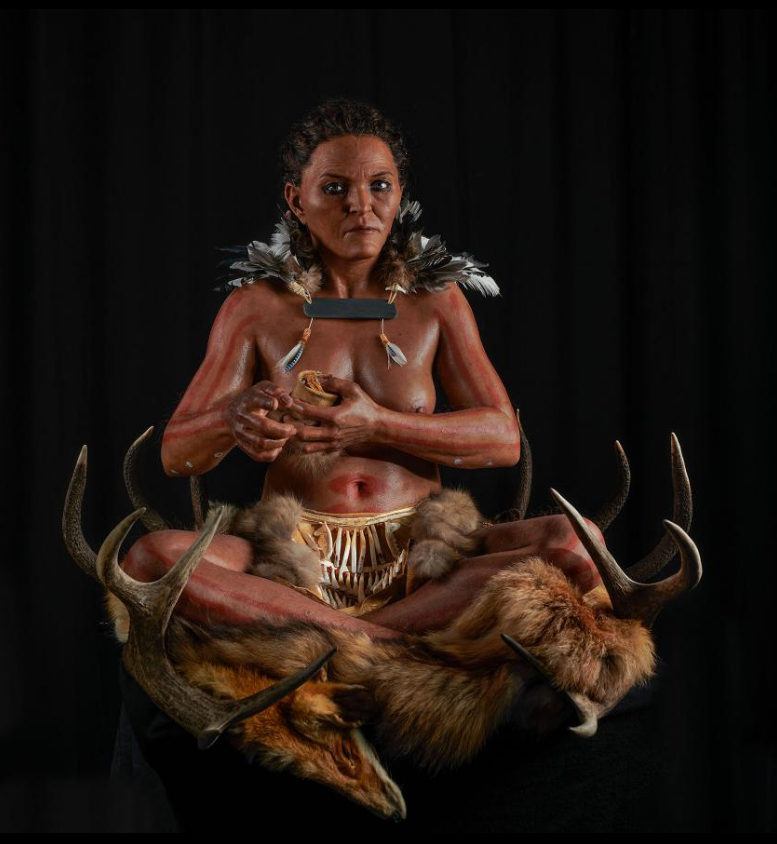
Her real name was likely last uttered some 7,000 years ago in the fertile marshes and forests of what is now southwest Sweden. But while that name is forgotten to history, a team led by archaeologist and artist Oscar Nilsson was able to breathe life into her remarkable burial with a reconstruction that will be unveiled at Sweden's Trelleborg Museum on November 17.
The woman was buried upright, seated cross-legged on a bed of antlers. A belt fashioned from more than 100 animal teeth hung from her waist and a large slate pendant from her neck. A short cape of feathers covered her shoulders.

From her bones, archaeologists were able to determine that she stood a bit under five feet tall and was between 30 and 40 years old when she died. DNA extracted from other individuals in the burial ground where she was found confirmed what we know about Mesolithic peoples in Europe — that they were dark skinned and pale eyed.
Comment: From the article referenced:
"Eye pigmentation is determined by a specific gene and a particular variant in the gene," says Thomas. "For skin there are a number of variants."
The advent of agriculture
Lars Larsson recalls excavating Burial XXII at the archaeological site of Skateholm, near Trelleborg, in the early 1980s. It was one of more than 80 ancient graves recorded at Skateholm, which ranged in dates from roughly 5,500 to 4,600 B.C. and included a variety of burial types, including people interred in pairs or with dogs, and individual dogs buried with rich grave offerings. Burial XXII was one of only a handful of seated interments, however, and archaeologists decided to excavate the burial as a single block that would to be transported to a lab for further investigation.
"That may have been the most difficult grave we excavated at Skateholm," says Larsson, a professor emeritus of archaeology at Lund University.
Skateholm and other late Mesolithic burial sites in the region along the southern Scandinavian coastline hold particular interest to archaeologists as they reveal communities of hunter-gatherers that continued to flourish for nearly a thousand years after Neolithic farmers brought agriculture into mainland Europe.
It appears that geographical isolation wasn't the reason for the late arrival of farming in Scandinavia, says Larsson, pointing to grave goods found at Skateholm that suggest trade contacts with agricultural communities on the European mainland. Rather, it was a choice.
"People tend to think of hunter-gathers as uncivilized humans," Larsson says, "but why would they transition to agriculture when they had a great situation with hunting and gathering and fishing?"
A gateway between worlds
While researchers relied on human bones and DNA to create the physical reconstruction of the woman, Larsson is reluctant to imagine her role in society apart from saying it was "distinctive."
Ingela Jacobsson, director of the Trelleborg Museum, agrees. "She had some sort of special position in society considering everything that she was buried with, but beyond that we cannot make any sort of determinations."
The artist in Oscar Nilsson, however, zeroed in on what he thought he saw. "You can interpret the evidence in many ways, but in my eyes she is definitely a shaman. She's buried sitting up on the horns. It's very striking and she very obviously was a person of great importance and dignity," he says.
Nilsson's forensic technique starts with an exact 3D replica of the original skull, scanned, printed, and then modeled by hand to reflect bone structure and tissue thickness based on the individual's origin, sex, and estimated age at death.
For the body, he recruited an acquaintance with a similar height and build to pose cross legged. Nilsson and his colleagues Eline Kumlander and Cathrine Abrahamson took plaster molds of the body model that were later cast in silicone. The clothes and adornments — including the belt fashioned from 130 animal teeth — were sourced locally and crafted by Helena Gjaerum.
Comment: If this woman was a hunter-gatherer it's likely her diet was massively different to the artist's friend which would mean that the comparison is lacking.
But what draws the most attention is the woman's riveting, intense expression.
"I seldom make reconstructions that have so much character," says Nilsson, "but she is a character. As we came to the conclusion that she was a shaman, it was easier to create her facial expression. She's not moving her facial muscles much, but it feels like she is communicating."
"She's like a gateway between our world and the other world," he adds, "and that has to be recognized in her face."
Museum director Jacobsson says that she got goose bumps the first time she saw the reconstruction. "There was a special look in her eyes; it was really something."
Maria Jiborn, an educator at the Trelleborg Museum, says she felt a strange sense of déjà vu when she looked into the face of the Mesolithic woman. "I remember thinking, hmm, haven´t we met before? Like she was familiar in some funny way. She probably looks like some distant acquaintance."
"We are all humans through time and space," she adds.
The reconstruction will be revealed on November 17 as part of the permanent exhibition "Eye to Eye," which features several of the Skateholm burials, at the Trelleborg Museum. For more information, visit the museum's website or Facebook page.




the replacement of a gap in a person's memory by a falsification that he or she believes to be true
One could also read it this way, a gap in a persons education by falsification that he believes to be true.